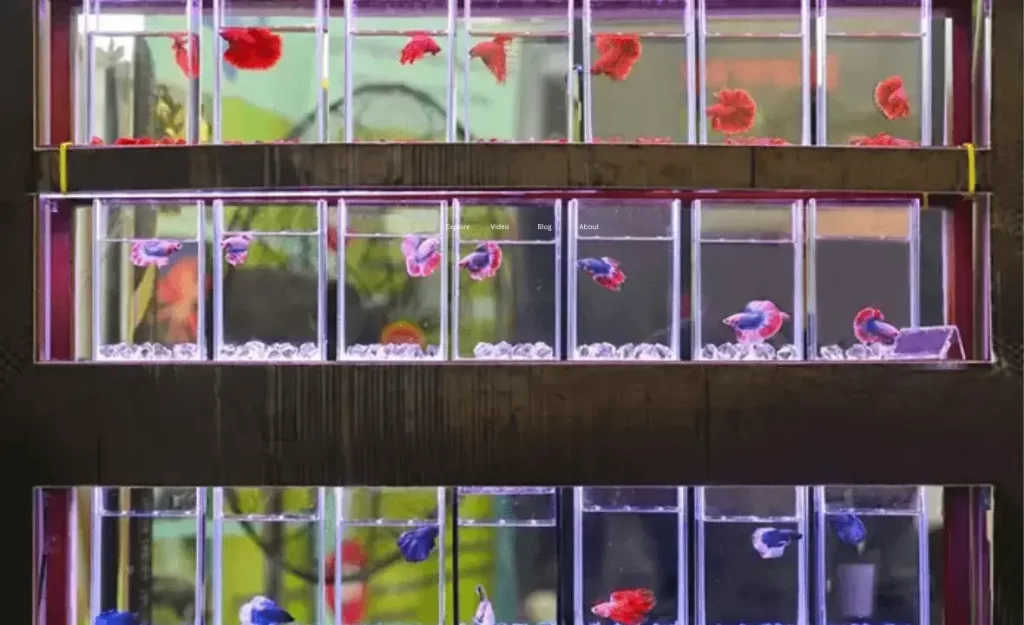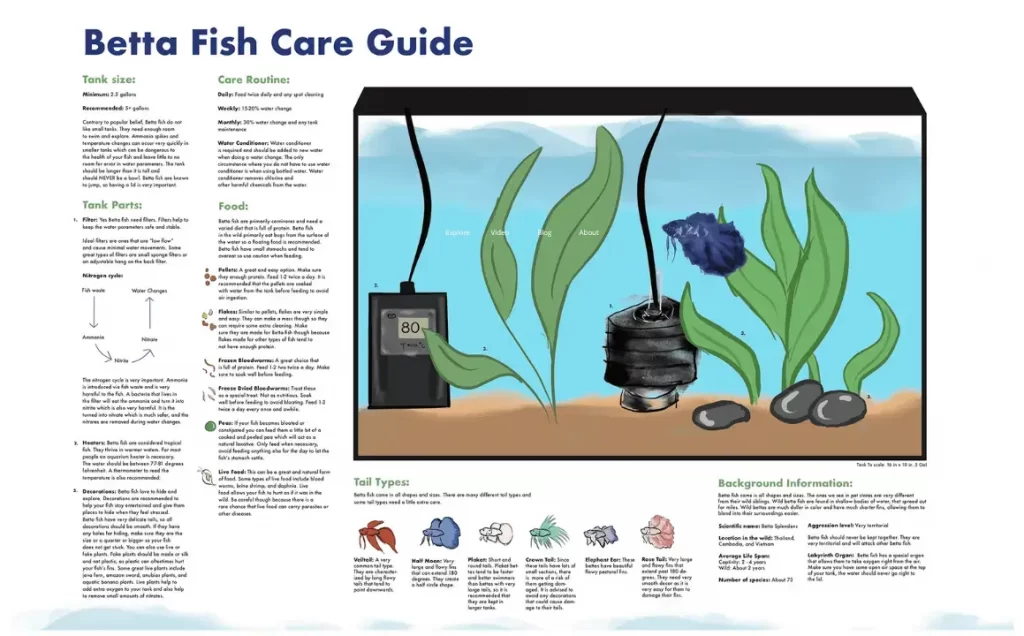
Betta fish, often known as Siamese fighting fish, have won the hearts of many pet owners with their captivating colors and beautiful fins. Because of their image as low-maintenance pets that can flourish in small aquariums, their popularity has skyrocketed.
However, while betta fish are tough creatures, they still require regular care and attention to ensure their well-being. It is critical to create an ideal environment for these tropical freshwater fish.
Betta fish, which originated in Southeast Asia, have unique environmental requirements that must be addressed in order to enhance their overall health and lifespan.
A suitable tank setup for betta fish care, an adequate water temperature, and clean water can dramatically improve the quality of life for your betta fish. It can lead to stress, weaker immune systems, and a variety of health problems if they neglect their environmental needs.
To ensure your betta fish’s well-being, it’s critical to learn and follow the proper care standards, allowing them to thrive in their surroundings and live a happy, meaningful life.
Table of Contents
Bettas in the Wild: Where Do They Come From?
Natural habitat and characteristics of betta fish:
Betta fish, scientifically known as Betta splendens, are freshwater fish of the gourami family. They are native to Southeast Asia’s rice fields, slow-moving streams, and small ponds.
Bettas, which are known for their brilliant colors and flowing fins, come in a wide range of colors, including red, blue, yellow, and even multi-colored combinations.
They have a labyrinth organ that allows them to breathe air from the surface of the water.
Creating their natural habitat in captivity:
Betta fish require a natural environment to thrive. Bettas live in warm tropical waters with temperatures ranging from 75°F to 80°F (24°C to 27°C). An aquarium must replicate these temperature conditions to ensure that its physiological systems work properly.
Another important component of reproducing their natural environment is incorporating foliage and hiding areas. Bettas encounter dense aquatic plants in the wild, such as Amazon swords, Java ferns, and floating vegetation.
These plants provide bettas with cover, resting locations, and territories to claim. A betta aquarium with live plants, floating logs, and caverns gives a sense of security and decreases stress.
Special Adaptations in Betta Fish
Bettas, which are members of the suborder Anabantoidei, have extraordinary special adaptations that allow them to flourish in their particular aquatic environments. Other members of the suborder, including dwarf gouramis, paradise fish, and pearl gouramis, share these adaptations.
The existence of a specialized organ known as the labyrinth organ is one important adaptation in these fish. They can breathe air thanks to this organ, which functions as a primitive lung.
Bettas may swim to the water’s surface in conditions with low oxygen levels and inhale air bubbles to get oxygen into their labyrinth organ. Other fish would struggle in environments with low dissolved oxygen levels, but they can because of their adaptability.
The labyrinth organ also has another important function. Betta fish may come upon small bodies of dried-up water in the wild. Bettas are capable of displaying astonishing behavior in such desperate circumstances.
In quest of a new environment, they have the ability to leap out of the water and flop around the ground for a short distance. Their remarkable capacity for short-term survival without water demonstrates their flexibility and toughness.
Betta fish exhibit their incredible capacity to live in difficult conditions through these unique adaptations. They can access oxygen as necessary thanks to their labyrinth organ, which ensures their ability to breathe even in low-oxygen environments.
Additionally, in times of drought or other environmental challenges, their temporary ability to leave the water gives them the chance to look for other habitats.
Fish Care Guide Sheet For Betta
Tank Setup:
- Pick a tank with a minimum capacity of 5 gallons to provide your fish with plenty of swimming room.
- Include a heater to keep the water at 78–82°F (25–28°C) at all times.
- To maintain clean water without generating powerful currents, use a mild filter.
- To create a cozy space, including live or silk plants and hiding places.
Aquatic Quality:
- To maintain ideal water conditions, perform weekly water changes of 25–50% on a regular basis.
- To get tap water free of chlorine and chloramine, use a water conditioner.
- To make sure ammonia, nitrite, and nitrate levels are within safe ranges, perform routine water parameter tests.
- Keep your pH level at or near 7.0.
Feeding:
- As the primary diet, use a high-quality pellet or flake food formulated for bettas.
- Add periodic goodies like brine prawns or freeze-dried or frozen bloodworms to the diet.
- Feed the fish in small pieces that they can finish in two minutes or less, 2-3 times per day.
Maintenance:
- Regularly remove debris from the gravel or substrate by gently siphoning it into the tank.
- To get rid of collected trash, rinse the filter media in the tank’s water.
- To maintain the purity of the water, remove any dead or decaying plant stuff.
- Any illness should be closely watched for and treated right away.
Enhancing the Environment:
- To provide protection and ease stress, provide hiding places such as caverns or plants.
- Bettas shouldn’t be kept in tanks with aggressive fish.
- Encourage your betta to move about or vary the decor of the tank on occasion.
Insights and Care:
Keep an eye out for any alterations in your betta fish’s behavior, appetite, or appearance.
If you observe symptoms of sickness, seek guidance from a veterinarian who is knowledgeable about fish care.
Make sure your betta receives the right care and attention by being aware of their needs.
1. Setting Up the Aquarium

Tank selection and size recommendations for betta fish:
When selecting a tank for your betta fish, make sure it has enough space for them to swim and explore. A minimum tank size of 5 gallons is recommended, but larger tanks of 10 gallons or more are even better. Avoid using small bowls or containers since they restrict the fish’s movement and endanger their health. Choosing a larger tank also results in more stable water parameters.
Choosing the right substrate and decorations:
For a betta fish aquarium, picking the right substrate is crucial. A smooth gravel or sand floor is preferable since it protects their fragile fins. Avoid using sharp or abrasive objects that could rip their fins or harm their fragile bodies.
As decorations, include live or silk plants, caverns, and other structures so that your betta fish can hide and rest. Live plants not only provide beauty to the environment, but they also improve water quality by collecting nitrates and providing natural filtration. Plastic plants with sharp edges should be avoided since they can injure the betta fish.
Temperature and lighting requirements:
Betta fish require the perfect water temperature to thrive. The ideal range for them is between 24°C and 27°C, or 75°F and 80°F. To keep the temperature within this range stable, use a trustworthy aquarium heater. A thermometer should be inserted into the tank to continuously check the water’s temperature.
Lighting is yet another crucial factor to take into account. As betta fish like moderate to low lighting, make sure the tank has a light source but that it is not excessively bright or harsh.
Consider using natural indirect lighting from a nearby window or a low-watt aquarium light. Similarly, establishing a consistent cycle of light and dark will support their natural sleep patterns and replicate their natural habitat.
Purification and maintenance of water:
For betta fish’s health and well-being, clean, chemically balanced water is essential. Betta fish require clean, chemically balanced water in their aquariums. Stress, illnesses, and even death are all consequences of poor water quality.
Regular cleaning of the tank is essential to remove any accumulated waste, extra food, and dirt. In order to avoid hazardous situations that could injure the fish, it is also essential to maintain good water chemistry by keeping an eye on the levels of ammonia, nitrite, nitrate, and pH.
Proper filtration system and water parameters:
A suitable filtration system is necessary for maintaining the best quality of water in a betta fish tank. A filter aids in the removal of physical impurities and poisons from the water, including ammonia and nitrites. Betta fish enjoy quiet water, so choose a mild filter with a flow rate that is ideal for them. Stay away from strong water currents that can fatigue or upset them.
Ammonia and nitrite levels in water should always be nil because betta fish are poisonous to these compounds. Regular water changes should be made to maintain low nitrate levels. The optimal pH range, which ranges from slightly acidic to neutral, is 6.5 to 7.5.
Regular water changes and testing:
Water quality must be maintained by doing routine water changes. To get rid of pollutants and waste that have accumulated, try to replenish around 25% of the tank’s water each week.
During water changes, clean the substrate by using a siphon or gravel vacuum to get rid of any debris and uneaten food.
Additionally, use a trustworthy aquarium water test kit to routinely check the water’s parameters. As a result, you may check the levels of ammonia, nitrite, nitrate, and pH to make sure they are within the acceptable range for betta fish.
Your betta fish will live in a healthy environment if the water is kept clean and chemically balanced through proper filtration, routine water changes, and water parameter monitoring.
As a result, there is a far lower chance of stress, illness, and other health problems, ensuring that your betta fish thrives in its aquarium environment.
2. Feeding and Nutrition
Betta fish diet recommendations:
The entire health and vigor of betta fish depend heavily on the availability of a balanced diet. A range of nutritious foods of the highest quality should make up their diet. In their native environment, betta fish eat mostly zooplankton, tiny insects, and insect larvae. In captivity, it’s crucial to closely resemble this diet as possible.
Food types: pellets, frozen, live, and treats Betta fish can be fed in a variety of ways, including:
1. High-quality pellets: Seek out pellets created especially for betta fish as they supply vital nutrients. Bettas are surface feeders, so choose pellets that sink slowly.
2. Frozen or freeze-dried foods: Provide alternatives like bloodworms, daphnia, brine prawns, and other small invertebrates that are frozen or freeze-dried. These give them diversity and mimic their typical diet.
3. Live foods: Since brine prawns and small worms are incredibly nourishing and stimulating for betta fish, occasionally offering live foods like these can be advantageous. To prevent spreading infections, make sure the living foods originate from reliable sources.
4. Treats: As a complement to their regular diet, treats can occasionally be offered. Examples include freeze-dried or live blackworms, daphnia, or tiny bits of fruit like diced cucumber or peas that have had their skins removed.
After feeding, don’t forget to remove any uneaten food to keep it from spoiling and lowering the quality of the water. The behavior and physical condition of your betta fish must be observed in order to change the feeding schedule or portion size as needed.
Your betta fish will get the nutrients they need for the best health and growth if you give them a balanced diet that includes high-quality pellets, frozen or live foods, and occasional treats. You can also do this by sticking to a regular feeding schedule and using the right amount of size.
3. Providing Hiding Places
A Betta fish hiding spot is important for a variety of reasons:
Betta fish need enough hiding places in their aquarium to live happily. Numerous benefits of hiding places include a sense of security, stress relief, and the encouragement of natural behaviors.
Betta fish need their own room to hide and rest because they are naturally solitary. Additionally, hiding spots provide defense against prospective attackers, enabling bettas to form territories and engage in their natural behaviors more easily.
Different types of hiding places: vegetation, caverns, and other natural features:
You can include many kinds of hiding places in the betta fish aquarium:
1. Tunnels and caves: Betta fish can find enclosed areas to withdraw to and rest by adding caves or tunnels constructed of aquarium-safe materials. Ceramic, PVC pipes, or even organic materials like coconut shells, can be used to create these structures.
2. Live or silk plants: Live or silk plants, which are dense vegetation, are great hiding places for betta fish. It is possible to create lush regions where bettas can find refuge and feel safe with plants like Java moss, Anubias, or Amazon swords.
3. Additional structures: You can also include additional structures, such as driftwood, rock formations, or ornamental aquarium decorations that provide bettas with hiding and exploring spaces.
Your betta fish will live in a more enjoyable environment if you provide them with a choice of hiding spots. These hiding places help to maintain their mental and emotional health in addition to providing them with physical protection. You will feel content knowing that your betta fish have a secure and cozy place to call home as you watch them use these hiding spots and engage in normal behaviors.
4. Socialization and Tankmates
Here are some instructions for introducing betta fish to tankmates:
To maintain compatibility and reduce hostility, keep the following rules in mind while choosing betta fish tankmates:
- Add tankmates once the betta fish has established its territory and become adapted to its surroundings.
- Select tank mates who are calm and non-aggressive.
- Steer clear of aggressive or fin-nipping species that could hurt or stress the betta fish.
- During the initial introduction phase, pay special attention to how the betta fish are getting along with their new tankmates.
Some types of fish can live alongside betta fish, though they are typically best kept as a group:
1. Tiny, calm communal fish: Neon tetras, rasboras, and guppies are a few examples. Avoid animals with long, slender fins since they could make people aggressive.
2. Fish that live on the bottom of the tank: Corydoras catfish or little loaches can be good tankmates because they reside in the tank’s lower levels and are less prone to tangle with betta fish.
3. Snails and shrimp: Invertebrates such as cherry shrimp or amano shrimp or nerite or mystery snails can make good tankmates. However, take care when handling prawns as some bettas could consider them to be prey.
Keeping an eye on fish behavior and dealing with aggression:
It’s critical to pay close attention to how the betta fish and its tankmates behave. Incompatibility problems may be indicated by aggressive behaviors from the betta fish, such as flaring, chasing, or fin pinching. To avoid harm to either fish if aggressiveness ensues, you might need to remove the tankmate.

It may be possible to lessen hostility by offering plenty of hiding places and utilizing plants or decorations to block the betta fish’s line of sight. If the aggressiveness continues, be ready to separate the betta fish and tankmate.
Keep in mind that each betta fish has its own personality, so compatibility may vary. It’s crucial to exercise patience, watch how they interact, and be ready to adjust or make special arrangements if required.
Your betta fish’s and its tankmates’ health and safety should always come first.
5. Disease Prevention and Healthcare
Common ailments and their symptoms in betta fish:
Betta fish are prone to a number of ailments, so being familiar with them will help you spot and treat them as soon as possible.
Ones that affect betta fish frequently include:
1. Fin rot: Fins that are ragged or falling apart are symptoms.
2. Ich (white spot disease): Tiny white spots that resemble salt grains that develop on the body and fins of fish.
3. Gold Rust: There are fine, rust, or gold dust-like particles on the fish’s body, which indicates velvet sickness.
4. Dropsy: A bloated appearance with an enlarged abdomen and elevated scales.
5. Fungal infections: growths like cotton on the fins or body of the fish.
Careful maintenance advice for preventing diseases:
The best way to care for your betta fish is to take preventive measures. Here are some recommendations for illness prevention:
- Keep water clean and chemically balanced by changing the water frequently and using the right filtration.
- Refrain from overfeeding your betta fish since too much food might result in bad water quality and
- To stop the spread of disease, quarantine fresh fish and plants before adding them to the main tank.
- Maintain a stress-free atmosphere in the aquarium by offering hiding spots, acceptable tank mates, and a regular feeding and lighting schedule.
- Steer clear of abrupt changes in water factors like pH or temperature, which can stress fish and impair their immune systems.
What to do if your betta fish is ill
It’s critical to respond quickly if your betta fish becomes ill in spite of your best efforts. If you notice any signs of disease, you should take the following actions:
First, isolate the ill fish in a separate quarantine tank to stop the disease from spreading to other fish in the tank. As a result, the danger of infection will be reduced and specialized care will be possible.
Next, carry out an in-depth study to pinpoint the precise ailment or symptoms that your betta fish is exhibiting. Your approach to therapy and care will be guided by your knowledge of the precise condition.
Make any necessary adjustments to the quarantine tank’s water quality. To create an atmosphere that is more conducive to healing, this may entail controlling the temperature or enhancing the quality of the water.
Conclusion
Our Betta Fish Care Guide covers key topics that will help you provide your betta fish with the best habitat possible. We started off by introducing betta fish, a common pet that is renowned for its vivid colors and flowing fins.
For these gorgeous creatures to flourish and live long, healthy lives, certain conditions must exist. You may promote an aquarium fish’s general health, happiness, and longevity by closely reproducing its natural habitat, keeping clean, chemically balanced water, delivering a nourishing meal, providing hiding places, and carefully choosing compatible tank mates.
As responsible pet owners, it is our duty to provide the best care for our betta fish. By implementing the guidelines discussed in this blog post, you can create the optimal environment your betta fish needs.
Remember, each betta fish is unique, and it’s important to observe their behavior, adjust care as needed, and seek professional advice if necessary. As betta fish partners, let’s make a commitment to giving them the best care and ensuring that they thrive in the ideal environment we provide for them.


